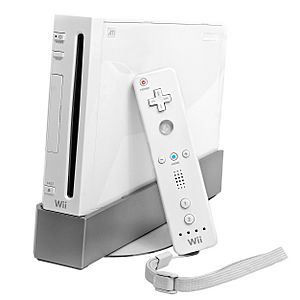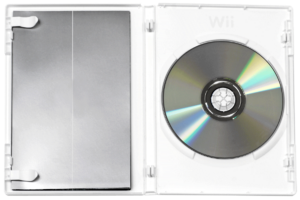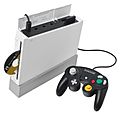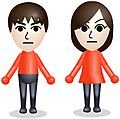Wii facts for kids
 |
|

Original white Wii standing upright on its stand next to a Wii Remote
|
|
| Also known as |
|
|---|---|
| Developer | Nintendo IRD |
| Manufacturer | Foxconn |
| Type | Home video game console |
| Generation | Seventh generation |
| Release date |
|
| Retail availability |
|
| Introductory price | |
| Discontinued |
|
| Units shipped | 101.63 million (as of September 30, 2019[update]) (details) |
| Media |
|
| Operating system | Wii system software |
| CPU | IBM PowerPC Broadway @ 729 MHz |
| Memory | 24 MB 1T-SRAM @ 324 MHz (2.7 GB/s) + 64 MB GDDR3 SDRAM |
| Storage | 512 MB NAND flash memory |
| Removable storage | |
| Display | |
| Graphics | ATI Hollywood @ 243 MHz |
| Controller input |
|
| Connectivity |
|
| Online services |
|
| Dimensions |
|
| Weight |
|
| Best-selling game |
|
| Backward compatibility |
GameCube |
| Predecessor | GameCube |
| Successor | Wii U |
The Wii (pronounced WEE) is a home video game console made by Nintendo. It first came out on November 19, 2006, in North America. After that, it was released in other parts of the world in December 2006. The Wii was Nintendo's fifth main home console. It followed the GameCube. The Wii was part of the seventh generation of video game consoles. Other consoles in this generation included Microsoft's Xbox 360 and Sony's PlayStation 3.
Nintendo's president, Satoru Iwata, wanted the Wii to be different. He didn't want it to compete with Microsoft and Sony on super powerful graphics. Instead, he wanted to reach more types of players with new ways to play. Game designers Shigeru Miyamoto and Genyo Takeda led the console's creation. Its secret name was Revolution (RVL). The main way to play the Wii was with the Wii Remote. This wireless controller could sense motion. You could point it at the TV screen or use gestures to play games. The Wii was Nintendo's first home console that could connect to the Internet. This allowed for online games and digital distribution of games. You could get these through the Wii Shop Channel. The Wii could also connect wirelessly with the Nintendo DS handheld game console for some games. Early Wii models could even play GameCube games. Later, Nintendo made two cheaper Wii models. One looked like the original but couldn't play GameCube games. The other was the Wii Mini, a smaller, budget version. It removed features like online play and SD card storage.
The Wii and its games were cheaper to make than its rivals. This was because Nintendo focused less on super high power. The Wii was very popular when it launched. It was hard to find in stores in some places. The game Wii Sports came with most consoles. Many people thought it was the best game for the system. Other popular games included Super Mario, Legend of Zelda, Pokémon, and Metroid series games. Within a year, the Wii became the best-selling seventh-generation console. By 2013, over 100 million units had been sold. The Wii sold over 101 million units in total. It was Nintendo's best-selling home console until the Nintendo Switch passed it in 2021. As of 2022, the Wii is the fifth-best-selling home console of all time.
The Wii helped Nintendo become a major player in video games again. Its motion controls inspired other companies. Microsoft made the Kinect, and Sony made the PlayStation Move. Nintendo noticed that while the Wii attracted new players, serious gamers sometimes avoided it. The Wii's next console, the Wii U, tried to get those serious gamers back. The Wii U came out in 2012. Nintendo kept selling both consoles for another year. The original Wii was officially stopped in October 2013. However, Nintendo kept making and selling the Wii Mini until 2017. Some of the Wii's online services were available until 2019.
Contents
Different Wii Models
The Wii had a special code name: "Revolution." That's why its model numbers start with "RVL-". For example, the first Wii console was RVL-001.
Original Wii Bundles
When the Wii first launched, it came with many things. You got the console itself and a stand to place it upright. It also included one Wii Remote and a Nunchuk attachment. A Sensor Bar was in the box, too, with a stand for your TV. You also got a power adapter and two AA batteries for the Wii Remote. The bundle had a composite A/V cable to connect to your TV. In some places, like Europe, a SCART adapter was also included. Most bundles came with a copy of the game Wii Sports.
Updated Wii Console
The RVL-101 Model
This updated Wii model came out in North America on October 23, 2011. It was black and came with a black Wii Remote Plus and Nunchuk. It also included New Super Mario Bros. Wii and a special soundtrack for Super Mario Galaxy. In Europe, it launched on November 4, 2011, in white. It came with a white Wii Remote Plus and Nunchuk, plus Wii Party and Wii Sports. A special blue version was released in Europe on November 18, 2011. This blue bundle included Mario & Sonic at the London 2012 Olympic Games. Later, the North American bundle changed. It started including the original Wii Sports games instead of New Super Mario Bros. Wii and the soundtrack. This new bundle came out on October 28, 2012.
Smaller Wii Mini
The RVL-201 Model
The Wii Mini (model RVL-201) is a smaller, redesigned Wii. It has a disc drive that loads discs from the top. It first came out on December 7, 2012, only in Canada. It cost about $99.99 CAD. Later, it was released in Europe on March 22, 2013, and in the United States on November 17, 2013. The Canadian and European versions did not come with a game. However, all launch bundles in the United States included Mario Kart Wii. Nintendo also released many popular Wii games under its Nintendo Selects label. These were sold alongside the Wii Mini.
Fun Features of the Wii
Create Your Own Mii Character
The Wii introduced special player-made characters called Miis. Nintendo still uses Miis on the Wii U, Nintendo 3DS, and even the Nintendo Switch. Every player on a Wii was encouraged to make their own Mii. You could do this using the Mii Channel. Miis were used in games like Wii Sports. They were also used in system software like the Mii Channel. For example, in Wii Sports, you would pick your Mii. This Mii would become your character in the game. You could also share your Miis with other players through the Mii Channel.
Connect with Your Nintendo DS
The Wii console could connect wirelessly with the Nintendo DS. You didn't need any extra accessories for this. This connection let you use the Nintendo DS's microphone and touchscreen. They could become inputs for Wii games. The first game to use this was Pokémon Battle Revolution. Players with Pokémon Diamond or Pearl on their DS could use the DS as a controller for battles. Final Fantasy Crystal Chronicles: Echoes of Time was released on both DS and Wii. It allowed both games to progress at the same time. Nintendo also released the Nintendo Channel. This let Wii owners download game demos for games like Mario Kart DS. You could also download extra data to their Nintendo DS. This was similar to a DS Download Station. The console could also expand Nintendo DS games.
Go Online with Your Wii
The Wii console could connect to the Internet. It had built-in Wi-Fi. You could also use a USB-to-Ethernet adapter. Both ways let players use the Nintendo Wi-Fi Connection service. This service had several features for the console. These included Virtual Console, WiiConnect24, the Internet Channel, the Forecast Channel, the Everybody Votes Channel, the News Channel, and the Check Mii Out Channel. The Wii could also talk to other Wii systems. It did this by creating its own wireless LAN. This allowed for local multiplayer games on different TVs. Battalion Wars 2 was the first game to show this feature. It allowed multiple players on different TVs without a split screen.
Exciting Wii Games
Twenty-one games were ready for the Wii's launch day in North and South America. Another twelve games were planned for release later in 2006. Some launch titles in all regions included Wii Sports. This game came with most Wii consoles, except in Japan and South Korea. Other launch games were The Legend of Zelda: Twilight Princess, Sega's Super Monkey Ball: Banana Blitz, and Ubisoft's Red Steel. Metroid Prime 3: Corruption was supposed to be a launch title. But it was delayed until 2007. Nintendo also planned to release Super Smash Bros. Brawl at launch. However, its director, Masahiro Sakurai, said it was hard to adapt the game for the Wii's motion controls. This meant the game needed more time to be developed.
New Wii games included popular series from Nintendo. These were The Legend of Zelda, Super Mario, Pokémon, and Metroid. Other companies also made games for the Wii. These included Ubisoft, Sega, Square Enix, Activision Blizzard, Electronic Arts, and Capcom. More games were made for the Wii than for the PlayStation 3 or Xbox 360. Nintendo also started the New Play Control! series. These were improved versions of GameCube games. They were updated to use the Wii's motion controls.
Wii and Your Health
The Wii was promoted to help people be active and healthy. It has even been used in physical rehabilitation. This means it helped people recover from injuries or illnesses. Scientists have studied how the Wii affects health for different conditions. The most common uses for Wii in therapy were for stroke, cerebral palsy, Parkinson's disease, and for balance training. There haven't been many studies on possible bad effects from playing video games for therapy. For example, studies on falls are still needed as of 2016.
A study in the British Medical Journal found that Wii players used more energy. This was more than playing games where you sit still. But playing Wii was not enough to replace regular exercise. Some Wii players have had minor muscle or joint injuries. These are sometimes called Wiiitis, Wii knee, Wii elbow (like tennis elbow), or nintendinitis. These happen from playing too much or doing the same movements over and over. A few serious injuries have happened, but they are rare. Most injuries are mild.
In May 2010, Nintendo gave $1.5 million to the American Heart Association (AHA). The AHA then supported the Wii with its Healthy Check icon. This covered the console and two active games: Wii Fit Plus and Wii Sports Resort.
Images for kids
-
Satoru Iwata as Nintendo's president directed the company to design the Wii out-of-the-box to appeal to a broader range of players.
-
The first model of the Wii has Nintendo GameCube Memory Card and controller slots to provide backward compatibility.
See also
 In Spanish: Wii para niños
In Spanish: Wii para niños















